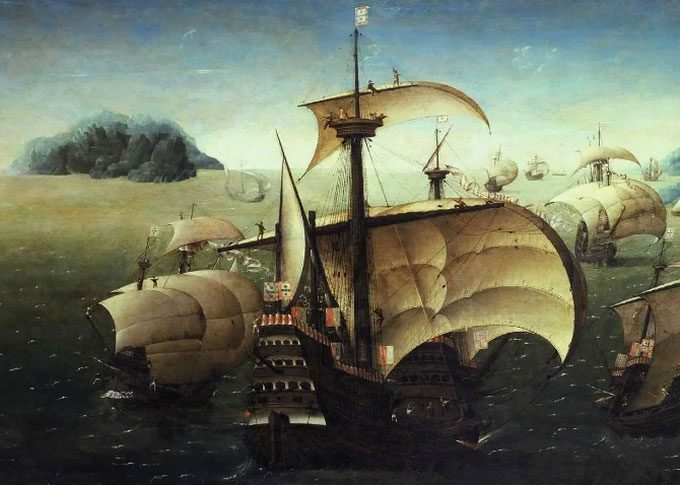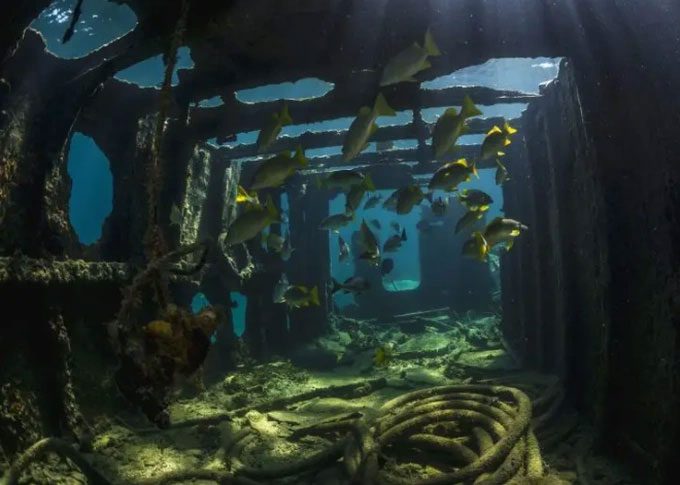For centuries, numerous efforts have been made to search for the wreck of a sunken ship along with its vast treasure, but to this day, no one has succeeded.
Although humans have been on Earth for about 200,000 years, there are still many lost treasures out there that we have yet to find. Among all locations, the ocean floor is perhaps the most abundant with treasures.

Flor de la Mar ship in a painting. (Image: Public Domain).
According to the United Nations (UN), it is estimated that there are at least 3 million shipwrecks, and their remains still lie on the ocean floor. Identifying and retrieving these wrecks could yield immense historical significance or even reveal priceless treasures.
The most famous among them is perhaps the Flor de la Mar – a ship laden with treasures that sank to the ocean floor over 500 years ago.
Portugal’s Naval Pride
As described by Discovery, this ship was approximately 36 meters long, weighed 400 tons, and was built in 1502 in the capital city of Lisbon, Portugal. It could carry a crew of around 500 people and was equipped with 50 cannons.
Dubbed “Flower Of The Sea”, the Flor de la Mar participated in several military campaigns over the 9 years of its service in the Portuguese fleet.

Many attempts have been made to find the wreck of the sunken ship along with its vast treasure, but to this day, no one has succeeded. (Illustrative image: Getty).
The Flor de la Mar began its maiden voyage in 1502 under the command of Estevão da Gama, a Portuguese navigator and explorer. During this time, the ship is believed to have discovered the Trindade and Martim Vaz islands (now part of Brazil).
On its return trip, the ship encountered several issues while sailing near the waters close to Mozambique Island. Witnesses at the time reported that the ship lost many bolts overboard, and was forced to anchor on the island for repairs.
Later, the Flor de la Mar returned to India under the command of General Jõao da Nova as part of the Portuguese India fleet. On this return trip, the ship faced problems once again and had to anchor at Mozambique Island for about 10 months for repairs.
In 1510, under the command of the legendary General Afonso de Albuquerque, the ship took part in the conquest of coastal cities including Curiati, Khor Fakkan, and Ormuz, while gathering wealth and treasures from everywhere it passed.
Notably, prior to this, the Flor de la Mar had severely deteriorated due to numerous repairs, to the extent that its voyages were considered reluctant.
The Massive Treasure Sunken Beneath the Ocean
On November 20, 1511, the ship encountered a severe storm while passing through the northeastern waters of Sumatra, Indonesia.
Records indicate that the crew attempted to find shelter during the storm, but the heavy cargo caused the ship to lose control, leading it to collide with a reef, splitting in two before sinking to the ocean floor.

The Flor de la Mar contained many priceless treasures. (Illustrative image: Getty Images).
It is estimated that about 400 people perished. However, Afonso de Albuquerque and a few others were fortunate to survive. Nevertheless, the entire colossal treasure aboard the ship was lost and has yet to be found.
Some documents suggest that the Flor de la Mar was carrying nearly 80 tons of gold, 200 chests filled with diamonds, rubies, emeralds, coins, perfumes, jewelry, and more.
This included some extremely rare artifacts, such as a gold bracelet belonging to the Rajah of Sabandar, 4 life-sized lions made of solid gold, and hand-drawn maps leading to the treasure.
The total value of these artifacts, along with the ship itself, is estimated by Discovery to be around £2.5 billion.
Over the centuries, numerous efforts have been made by the Portuguese government and treasure hunting organizations to locate the sunken ship and its immense fortune. However, to this day, no one has succeeded.
Many theories suggest that the treasure may be buried beneath layers of sediment on the ocean floor, making the search exceedingly difficult.


















































